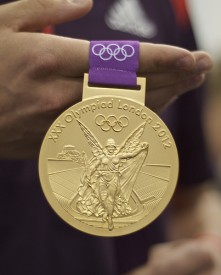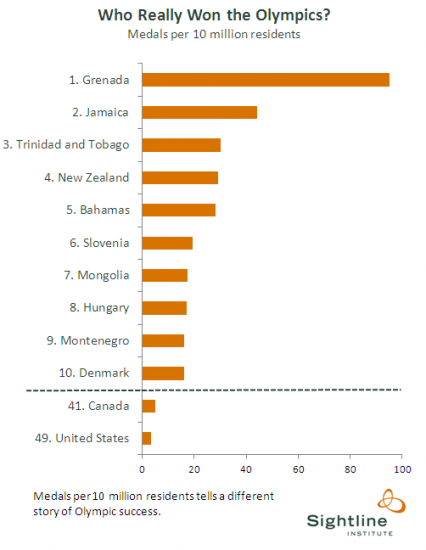The closing ceremony is over, the medals have all been awarded…but there’s still time to argue over Olympic glory. And since there are no more actual athletic competitions to judge, the only thing that we geeks have to argue about is the numbers.
By some measures, the US was the standout performer of the 2012 summer Olympics. With more golds, more silvers, and more total medals than any other nation, it sure looks like the US has a lock on the gold medal for most athletic country, right?
Not so fast. Sure, the US got a lot of medals. But there are also an awful lot of us: we’re the third most populous nation in the world, trailing only China and India. We’re also a wealthy nation—and as New York Times blogger Nate Silver convincingly argues here, wealthy nations have an Olympic-sized advantage in racking up medals. So, naturally, you’d expect a wealthy nation with lots and lots of residents to earn a lot of medals.
So after adjusting for population, how did the US do in the Olympics? Gauged by medals per capita, our performance was nowhere near medal-worthy. Among the 85 nations that received at least one medal, the US ranked 28th in the number of gold medals per capita, and a lowly 49th in total medals per capita. In a word…meh.
Interestingly, the three standouts in the medals-per-capita race were all Caribbean nations that specialize in track and field. Tiny Grenada netted just one medal—Kirani James‘s gold in the men’s 400m. Yet with a population of just 105,000, James’s performance earned Grenada far and away the most golds per capita, and also the most total medals per capita.
Coming in at silver in medals per capita was Jamaica. Usain Bolt got the headlines, but their entire short-distance track team was dominating, garnering 12 medals—including 4 of each flavor—from a national population of about 2.7 million. (That’s less than one one-hundredth of the size of the US.)
Nabbing the bronze in the per-capita medal race was Trinidad and Tobago, with 4 medals—a gold in the javelin and 3 third-place finishes in other track events—out of a population of 1.3 million. All three of the top per-capita medal earning nations have less economic output per capita than the US—which pushes them even farther ahead in the adjusted medal-winning rankings.
After the jump, the top 20 finishers in the medals per capita race:
| Rank | Nation | Medals per 10 million residents |
| 1 | Grenada | 95.2 |
| 2 | Jamaica | 44.3 |
| 3 | Trinidad and Tobago | 30.4 |
| 4 | New Zealand | 29.3 |
| 5 | Bahamas | 28.3 |
| 6 | Slovenia | 19.4 |
| 7 | Mongolia | 17.6 |
| 8 | Hungary | 17.1 |
| 9 | Montenegro | 16.1 |
| 10 | Denmark | 16.1 |
| 11 | Lithuania | 15.7 |
| 12 | Georgia | 15.6 |
| 13 | Estonia | 15.5 |
| 14 | Australia | 15.4 |
| 15 | Croatia | 14.0 |
| 16 | Belarus | 13.7 |
| 17 | Cuba | 12.4 |
| 18 | Netherlands | 11.9 |
| 19 | Cyprus | 11.9 |
| 20 | Qatar | 11.8 |
There’s perhaps some slim consolation for the US: China came in 2nd in the race for total medals; but adjusting for population pushes them all the way down to 74th place, even lower than the US. So perhaps the real lesson here is: if you want to win a medals-per-capita competition, your best strategy is to be a small country…and hope you’ve got a few people who can run really, really fast.
So what’s all this Olympic bean-counting doing on a sustainability blog? I thought it was a good illustration of a bigger principle: sometimes, to figure out how you’re really doing, you have to do the math. And when you turn performance measures on their side, a standout performance can seem ho-hum, and a mediocre performance can seem stellar. And on issue after issue, that’s exactly what our Cascadia Scorecard finds: places that lead the northwest on key sustainability indicators are often trailing far behind the globe’s real leaders. But that’s a story that you can only discover by actually exploring the data.
Update 3:55: We’ve made this into a chart, too!





Rodney Rutherford
Ha! I was just wondering about this today when I heard about the medal counts on the radio. I certainly didn’t expect that Sightline would be on the case, but finding this was a fun surprise.
Ross E. Mitchell
Since sustainability is the theme, how about medals per million bbl/day oil consumption?
In this case, the USA ranking is even worse, while China comes out just a little better than the USA, though both are way down in the rankings. Also, the Bahamas don’t look nearly so good on this sustainability metric, while Georgia, North Korea, Afghanistan, Kenya and Ethiopia, move into the top ten.
Rank Nation Medals per million bbl/day
1 Georgia 538.5
2 North Korea 461.5
3 Grenada 333.3
4 Mongolia 294.1
5 Montenegro 250.0
6 Afghanistan 208.3
7 Jamaica 190.5
8 Ethiopia 148.9
9 Kenya 141.0
10 Hungary 116.0
11 Moldova 100.0
12 Trinidad and Tobago 97.6
13 Azerbaijan 96.2
14 Croatia 87.6
15 New Zealand 86.8
16 Serbia 79.6
17 Cuba 78.2
18 Lithuania 74.6
19 Belarus 73.6
20 Uganda 71.4
21 Ukraine 67.6
22 Latvia 66.9
23 Botswana 66.7
24 Estonia 64.5
25 Denmark 63.9
26 Slovenia 63.5
27 Kazakhstan 59.6
28 Armenia 57.7
29 Gabon 55.6
30 Czech Republic 51.1
31 Slovakia 47.7
32 Romania 45.9
33 Great Britain 40.1
34 Uzbekistan 38.5
35 Russia 37.3
36 Australia 36.4
37 Tunisia 35.7
38 Ireland 34.9
39 Bahamas 28.6
40 Colombia 27.0
41 Tajikistan 25.0
42 Sweden 22.8
43 Bulgaria 22.0
44 Bahrain 21.3
45 Netherlands 19.8
46 Italy 18.3
47 France 18.3
48 Norway 18.1
49 Poland 17.7
50 Germany 17.6
51 Dominican Republic 16.8
52 Switzerland 16.5
53 Cyprus 16.4
54 Guatemala 14.1
55 Finland 13.8
56 Puerto Rico 13.3
57 South Korea 12.8
58 Qatar 12.0
59 Spain 11.8
60 South Africa 10.8
61 China 9.4
62 Japan 8.5
63 Brazil 8.4
64 Canada 8.1
65 Turkey 7.7
66 Islamic Republic of Iran 6.5
67 Argentina 6.5
68 United States 5.4
69 Greece 5.4
70 Belgium 4.8
71 Morocco 4.8
72 Portugal 3.6
73 Malaysia 3.6
74 Mexico 3.4
75 Hong Kong 3.3
76 Algeria 3.2
77 Thailand 3.0
78 Kuwait 2.8
79 Egypt 2.7
80 Chinese Taipei (Taiwan) 2.0
81 India 1.9
82 Singapore 1.9
83 Indonesia 1.5
84 Venezuela 1.3
85 Saudi Arabia 0.4
Rodney Rutherford
Another way to think about this is to divide large populations (or large oil consumers) into more equal sizes. What happens if you look at this on a per state basis?
Jacob Falcon
You people really are geeks and who cares about what you people think. Who really won the Olympics was U.S.A because of how many total medals we got and how many gold. So your wrong about who won won but your right on your data.
Clark Williams-Derry
Thank you for your interesting perspective, Jacob.
John Newcomb
Should recognize all the other websites that have been saying same thing for several days now:
http://www.medalspercapita.com/
http://www.medalsbypopulation.com/
http://www.cbc.ca/news/world/story/2012/08/09/f-efficient-olympics.html
However the whole Olympics is a farce by all states to spend a ton of taxpayers’ money for NO good reason. Its a relic of the Nazi Olympics, the focus on how many medals per country.
If sports is merely war by other means, check out 13 August Foreign Policy blog by John Norris for his correlation between guns and sports:
The Golden Gun – Want to win big at the Olympic Games? Buy a bunch of overpriced tanks and fighter jets:
http://www.foreignpolicy.com/articles/2012/08/13/the_golden_gun
Georgie Bright Kunkel
I have always thought that the Olympics by country was nationalistic but hardly fair.
I am a citizen of the world and don’t relate to competition by country any more.
Wish that if I ever wanted to cross country borders that I could just say “I am a citizen of the world” and that would be enough.
Corporations can cross country borders at will but citizens can’t do that. Since the corporation is now legally a person, shouldn’t the corporation have to get a passport to operate outside this country? Oh yes, I remember. The corporation is a person but does not have the responsibility that other persons have under the law.
What’s new?
geeksportsfan
I love to root for the “little guys” and watch the Olympic sports that you don’t get to see on network TV, like badminton, judo, volleyball, etc. And as much as I detest the nationalistic chest thumping that seems be part and parcel of the Olympics, in sports winning is winning. Despite the daily medal count, the Olympics isn’t a competition to see who is the greatest nation in the world. It’s to see who the greatest athletes are. You get the highest score, the fastest time you win – period, no asterisk that says, “we woulda’ won if only our national sports program had more money or people to recruit from”. By your logic, the Yankees didn’t really win the World Series, or the Lakers didn’t really win the NBA championship because they had a bigger payroll than the competition. That doesn’t mean I’m a fan of the big money programs. The disparity is part of what makes an upset so exciting or seeing someone become a national hero for winning a medal in a “minor league” sport so uplifting.
John Hansen
I like Ross Mitchell’s ranking by medals per million bbls/day, but it would be even better if it were further divided by population, say medals per million bbls/day/million residents – and I’m not sure where that leaves any country.